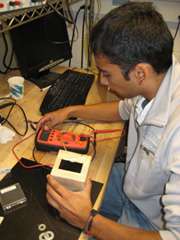Researchers and students to develop small CubeSat satellites

A satellite about the size of a loaf of bread will be designed and built at the University of Michigan and deployed to study space weather, thanks to a new grant from the National Science Foundation.
Undergraduate and graduate students will be heavily involved in this Radio Aurora Explorer (RAX) project, led by the University of Michigan and SRI International, a California-based independent research and technology development organization.
This CubeSat, as it's called, will be the first free-flying spacecraft built in part by U-M students. Members of the Student Space Systems Fabrication Laboratory (S3FL) will play an important role. S3FL is an organization that gives students practical space systems design and fabrication experience.
"I'm extremely excited about the student involvement. They will be an integral part of the team," said James Cutler, assistant professor in the Department of Aerospace Engineering and a principal investigator on the project.
CubeSats, developed about five years ago, are approximately four-inch cube-shaped devices that launch from inside a P-Pod, a special rocket attachment that was developed by California Polytechnic State University and Stanford University. There is a growing interest in CubeSats as they offer relatively inexpensive and simpler access to space. The RAX satellite will essentially be made of three CubeSats.
The RAX will measure the energy flow in the ionosphere, the highest part of Earth's atmosphere where solar radiation turns regular atoms into charged particles. Disturbances in the ionosphere can affect earth-to-space communications such as GPS signals, digital satellite television and voice and data transmission systems including Iridium and Globalstar.
"This project will help us better understand space weather processes, how the Earth and Sun interact, and how this weather produces noise in space communication signals—noise that translates to lower quality telecommunications capabilities and error in GPS signals," Cutler said.
The RAX satellite will act as a receiver that will pick up signals from a ground radar transmitter. These radar pulses will reflect off disturbances, or space weather phenomena, in the ionosphere.
RAX is scheduled for launch in December 2009. This will be a milestone for Kiko Dontchev, program manager in M-Cubed, the S3FL team that will be working with Cutler.
Dontchev, a master's student in space engineering, has been involved in S3FL since he was a freshman at U-M. Last year, he started the M-Cubed project with other students because they wanted to see the launch of a satellite they worked on. M-Cubed is designing a CubeSat that can take high resolution photos of earth, but it doesn't have a launch date yet.
"It's pretty incredible that we'll build and design a spacecraft that will actually fly," Dontchev said. "This project ensures that Michigan will have a profound footprint in the CubeSat community."
Michigan will receive $510,000 of the $891,000 RAX grant. The project's other principal investigator is Hasan Bahcivan, a research physicist at SRI International. The first launch opportunity for the NSF satellite program will be with the Department of Defense Space Test Program, aboard a Minotaur-4 launch vehicle out of Kodiak, Alaska. Commissioning and launch support for the mission will be provided by NASA Goddard Space Flight Center Wallops Flight Facility. RAX is scheduled to be the first in a series of CubeSat missions funded by the NSF to study space weather phenomenon.
Source: University of Michigan





















